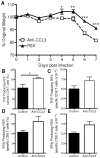The chemokine MIP1alpha/CCL3 determines pathology in primary RSV infection by regulating the balance of T cell populations in the murine lung
- PMID: 20195359
- PMCID: PMC2827540
- DOI: 10.1371/journal.pone.0009381
The chemokine MIP1alpha/CCL3 determines pathology in primary RSV infection by regulating the balance of T cell populations in the murine lung
Abstract
Background: CD8 T cells assist in the clearance of respiratory syncytial virus (RSV) infection from the lungs. However, disease after RSV infection is in part caused by excessive T cell activity, and a balance is therefore needed between beneficial and harmful cellular immune responses. The chemokine CCL3 (MIP1alpha) is produced following RSV infection and is broadly chemotactic for both T cells and natural killer (NK) cells. We therefore investigated its role in RSV disease.
Methodology/principal findings: CCL3 was produced biphasically, in both the early (day 1) and late (day 6-7) stages of infection. CCL3 depletion did not alter the recruitment of natural killer (NK) cells to the lungs during the early stage, but depletion did affect the later adaptive phase. While fewer T cells were recruited to the lungs of either CCL3 knockout or anti-CCL3 treated RSV infected mice, more RSV-specific pro-inflammatory T cells were recruited to the lung when CCL3 responses were impaired. This increase in RSV-specific pro-inflammatory T cells was accompanied by increased weight loss and illness after RSV infection.
Conclusions/significance: CCL3 regulates the balance of T cell populations in the lung and can alter the outcome of RSV infection. Understanding the role of inflammatory mediators in the recruitment of pathogenic T cells to the lungs may lead to novel methods to control RSV disease.
Conflict of interest statement
Figures






Similar articles
-
Differential regulation of GM1 and asialo-GM1 expression by T cells and natural killer (NK) cells in respiratory syncytial virus infection.Viral Immunol. 2008 Sep;21(3):327-39. doi: 10.1089/vim.2008.0003. Viral Immunol. 2008. PMID: 18788941 Free PMC article.
-
Respiratory Syncytial Virus (RSV) Pulmonary Infection in Humanized Mice Induces Human Anti-RSV Immune Responses and Pathology.J Virol. 2016 Apr 29;90(10):5068-5074. doi: 10.1128/JVI.00259-16. Print 2016 May 15. J Virol. 2016. PMID: 26962219 Free PMC article.
-
Respiratory syncytial virus infection is associated with an altered innate immunity and a heightened pro-inflammatory response in the lungs of preterm lambs.Respir Res. 2011 Aug 9;12(1):106. doi: 10.1186/1465-9921-12-106. Respir Res. 2011. PMID: 21827668 Free PMC article.
-
Protective and dysregulated T cell immunity in RSV infection.Curr Opin Virol. 2013 Aug;3(4):468-74. doi: 10.1016/j.coviro.2013.05.005. Epub 2013 Jun 25. Curr Opin Virol. 2013. PMID: 23806514 Free PMC article. Review.
-
Respiratory infections: do we ever recover?Proc Am Thorac Soc. 2007 Dec;4(8):618-25. doi: 10.1513/pats.200706-066TH. Proc Am Thorac Soc. 2007. PMID: 18073393 Free PMC article. Review.
Cited by
-
A nuclear factor-κB signaling pathway via protein kinase C δ regulates replication of respiratory syncytial virus in polarized normal human nasal epithelial cells.Mol Biol Cell. 2011 Jul 1;22(13):2144-56. doi: 10.1091/mbc.E10-11-0875. Epub 2011 May 11. Mol Biol Cell. 2011. PMID: 21562222 Free PMC article.
-
Vaccination with a Single-Cycle Respiratory Syncytial Virus Is Immunogenic and Protective in Mice.J Immunol. 2019 Jun 1;202(11):3234-3245. doi: 10.4049/jimmunol.1900050. Epub 2019 Apr 19. J Immunol. 2019. PMID: 31004010 Free PMC article.
-
Neonatal antibody responses are attenuated by interferon-γ produced by NK and T cells during RSV infection.Proc Natl Acad Sci U S A. 2013 Apr 2;110(14):5576-81. doi: 10.1073/pnas.1214247110. Epub 2013 Mar 18. Proc Natl Acad Sci U S A. 2013. PMID: 23509276 Free PMC article.
-
Lack of pathogenic involvement of CCL4 and its receptor CCR5 in arthritogenic alphavirus disease.bioRxiv [Preprint]. 2024 Aug 3:2024.07.31.606106. doi: 10.1101/2024.07.31.606106. bioRxiv. 2024. Update in: Immunohorizons. 2025 May 30;9(7):vlaf022. doi: 10.1093/immhor/vlaf022. PMID: 39131287 Free PMC article. Updated. Preprint.
-
Airway Epithelial Derived Cytokines and Chemokines and Their Role in the Immune Response to Respiratory Syncytial Virus Infection.Pathogens. 2019 Jul 19;8(3):106. doi: 10.3390/pathogens8030106. Pathogens. 2019. PMID: 31331089 Free PMC article. Review.
References
-
- Smyth RL, Openshaw PJ. Bronchiolitis. Lancet. 2006;368:312–322. - PubMed
Publication types
MeSH terms
Substances
Grants and funding
LinkOut - more resources
Full Text Sources
Medical
Molecular Biology Databases
Research Materials

